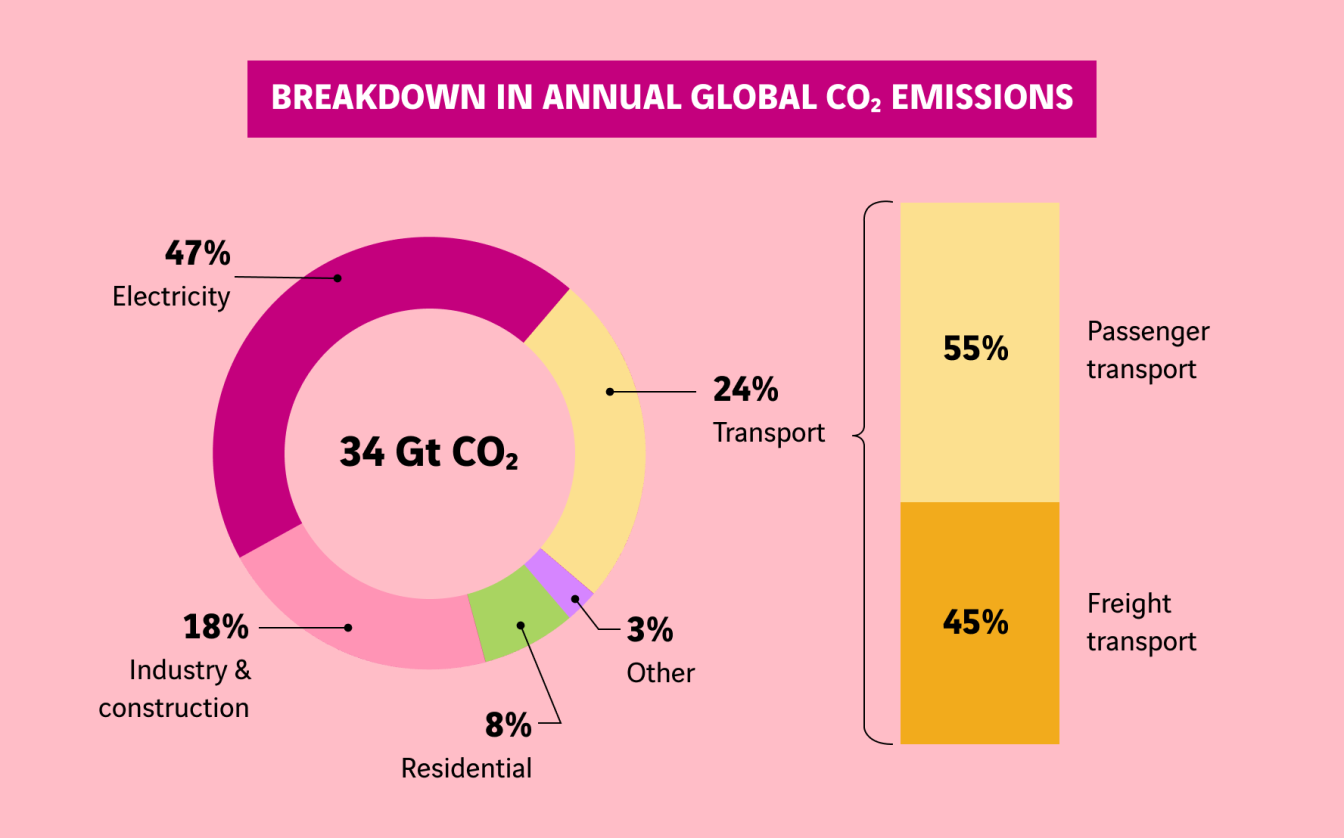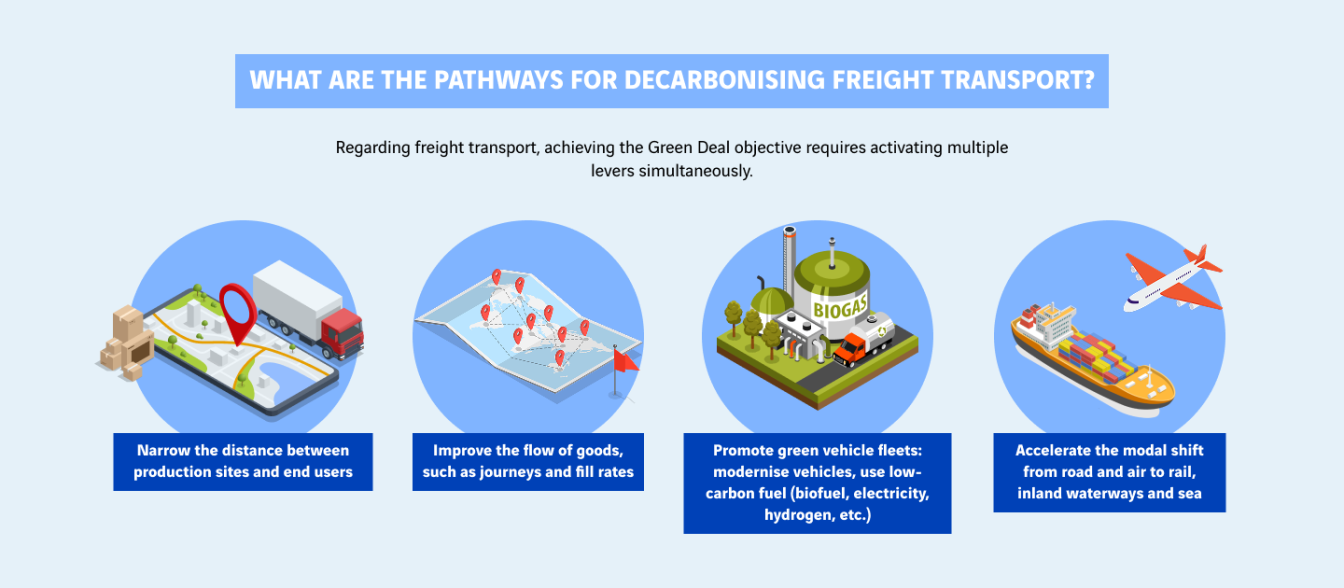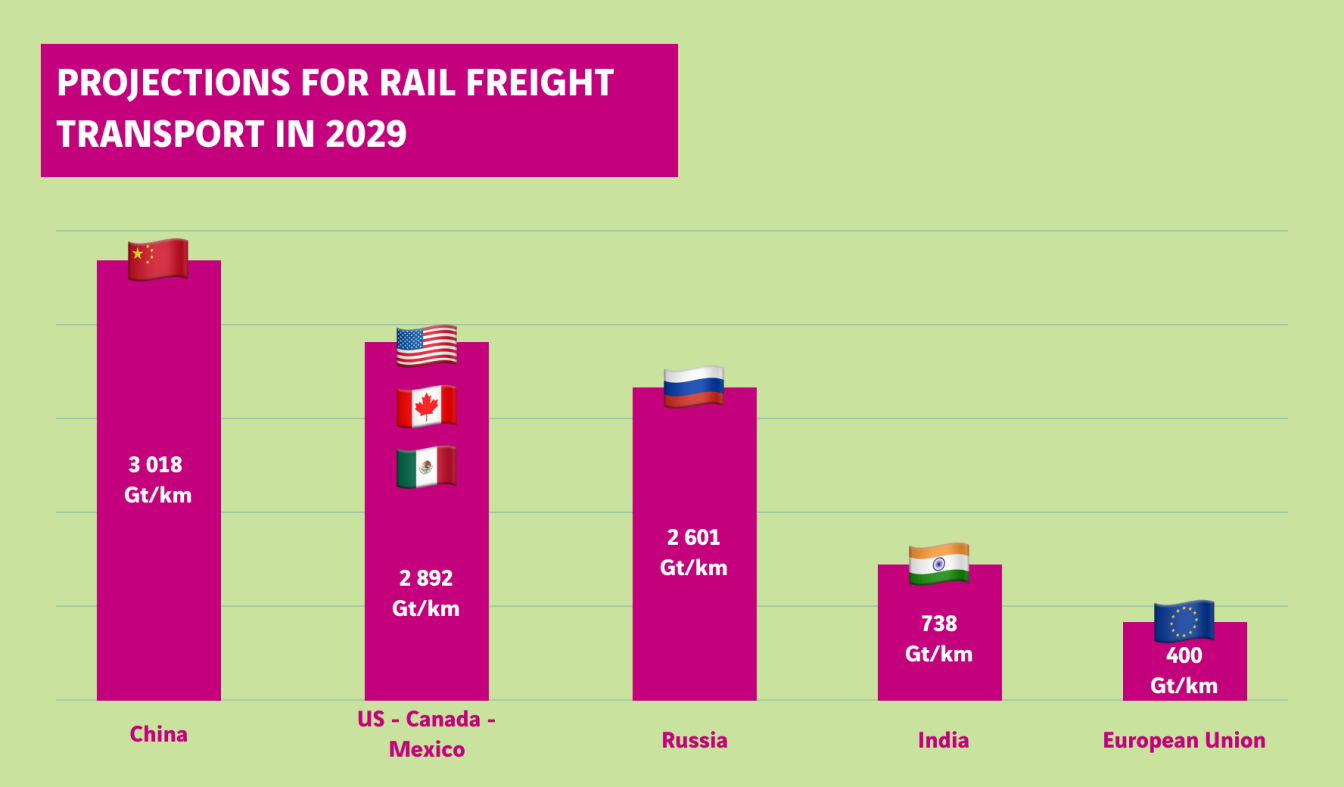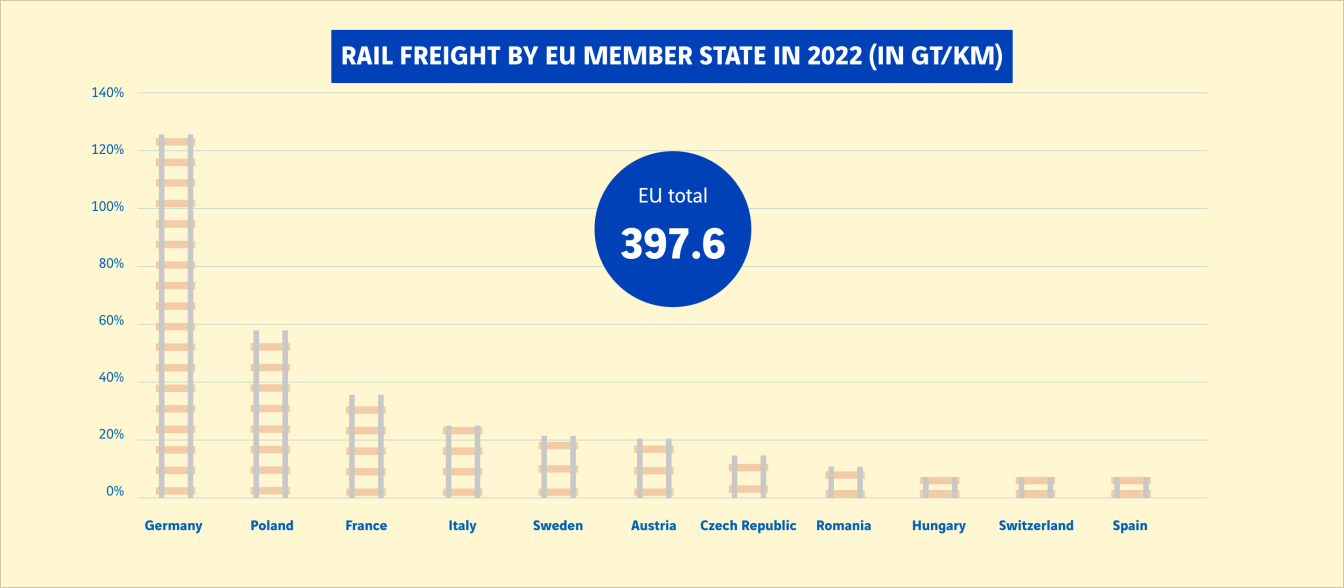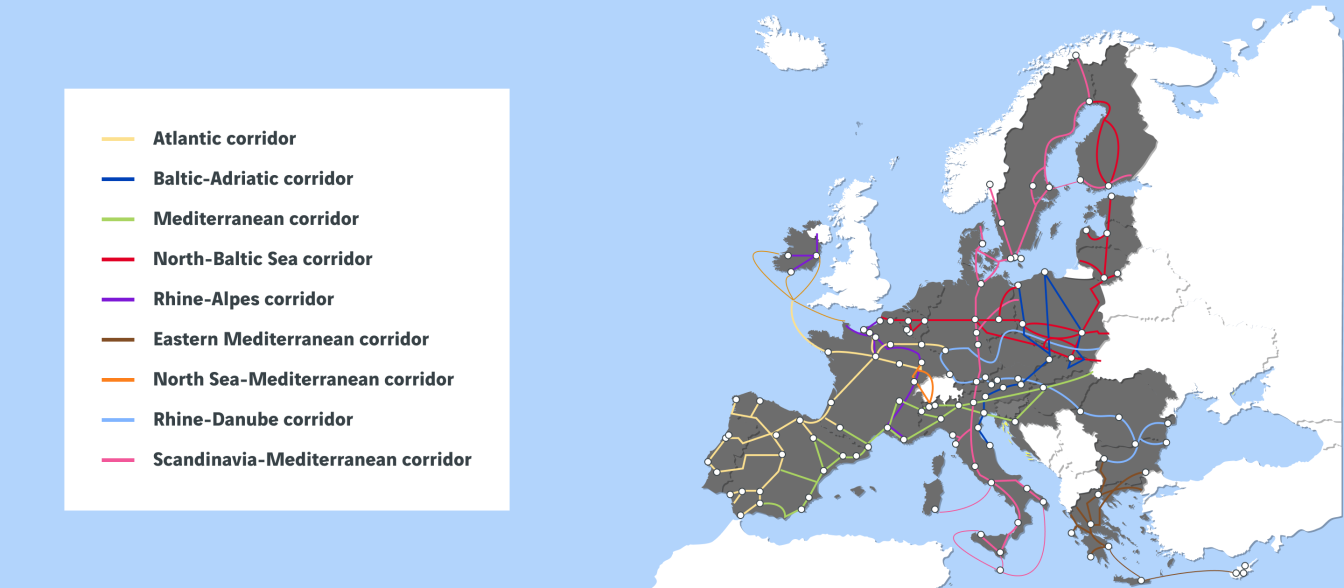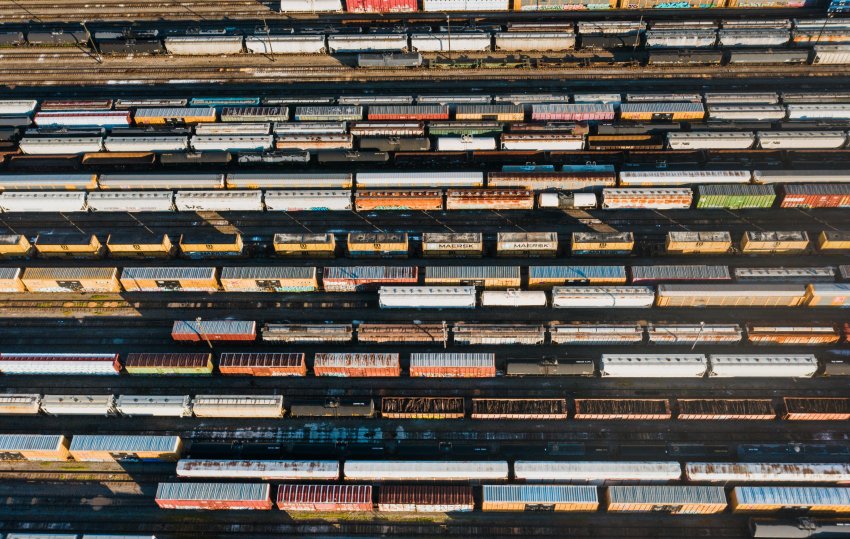
From road to rail: European freight transport heads down the decarbonisation track
Freight transport is an inherent part of any business or trade activity, and a region’s economic prosperity is directly related to the quality of its supply chain networks. As the effects of climate change continue to make their presence felt, urgent steps must be taken to decarbonise the transport sector, which is responsible for producing nearly a quarter of global greenhouse gas (GHG) emissions. Such action is illustrated by the European strategy aimed at unifying supply chains across the continent by giving rail freight a greater role.
Freight transport: the complex equation for achieving net zero
A major source of CO2 emissions
In 2019, the transport sector generated approximately 24% of the world’s CO2 emissions (baseline year used for identifying long-term trends, i.e. before the upheaval caused by the Covid-19 pandemic). Although passenger transport continues to top the list of contributors, freight transport is still the culprit behind 45% of these emissions and is responsible for 7 to 16% of the global carbon footprint depending on the source, year and scope.
Source : Carbone 41
-90 %
Objective for reducing the CO2 emissions from transport in Europe by 2050
The European Union (EU) blazes a trail
The EU has set the ambitious target of becoming the world’s first carbon-neutral continent by 2050. With this goal in mind, its Green Deal features a host of measures to decarbonise transport without eroding the prosperity of a strategic sector that represents approximately 5%2 of the EU’s GDP and employs over 10 million people (including 6 million for freight3).
Therefore, efforts should not only focus on modernising vehicles, but also improving every aspect of the supply chain. Rather than concentrating solely on a supply chain’s costs, action should also be taken to shrink its carbon footprint, since not all forms of transport are the same.
Carbon intensity underlying the equation
The carbon intensity is the key factor in the equation, which refers to how many CO2 emissions are produced for each ton of freight transported and for each kilometre travelled. However, the equation is a lot more complex that it would initially seem.
Source : ADEME4
When talking about the vehicles that generate the most greenhouse gas emissions, merchant ships are truly in a class of their own with their hulking fuel oil or diesel engines. Nevertheless, their gigantic payload capacity means that they are actually one of the least “carbon-intensive” forms of transport for very long-distance trade. Similarly, road transport may be the most intensive means of transport by far, but it plays an irreplaceable role in many situations, such as first and last-mile logistics. Basically, there is no way of building every factory around a port or delivering parcels to every recipient exclusively by rail.
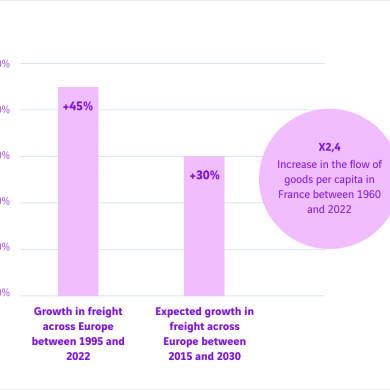
Freight: a constant rise in demand
Freight is one of the priority action areas in strategies aimed at mitigating greenhouse gas emissions and tackling climate change, especially since demand is tending to rise in step with the increase in living standards. Changes in consumption patterns are having a considerable effect on freight demand, such as the recent surge in online shopping and home deliveries.
The modal shift solution
In this particular context, the strategy involves developing multimodal transport. In other words:
- consider what would be the most effective transport method at every link in the supply chain;
- connect and organise the transport networks accordingly;
- ensure that goods can be effectively and seamlessly transferred from one mode of transport to another.
Europe is mainly taking a modal shift approach to improve the freight transport sector’s emissions. This process consists in replacing long-haul road traffic wherever possible (especially international trips) with journeys by rail and inland waterways.
The advantages of rail over road transport
- 6 times less energy use
- 6 times less energy use
- 8 times less air pollution
- 85 times less traffic accidents
Source : Rail Freight Forward12
Rail freight: the best and worst performers…
Due to historical and geographical reasons, rail freight in Europe has yet to reach the same level of development as in other comparably sized economic zones.
Source : Banque mondiale, Eurostat9
Major disparities can even be found within the European Union.
In Europe, Lithuania comes top of the class with 70% of all domestic freight transported by rail. Switzerland, which is home to the densest railway network in Europe, is another A-student with 40% of its domestic freight transport by rail, and that figure even reaches 70% for its international traffic across the Alps. In France, the modal split of rail is relatively low at approximately 9% in 2023, although there are plans to achieve a target of 18% by 203014.
The challenge: double the share of rail freight by 2030
When considering all forms of transport, the share of rail freight in the European Union has generally remained stable between 5% and 6%15 for several years, despite an increase in the volume of freight transported. When looking exclusively at land transport, that percentage rises to around 18%16, while the target for the Member States is to achieve a 30% modal share by 203017.
Infrastructures : heading towards a unified and improved european network
This is a highly ambitious goal. One of the pathways for reaching this target involves developing appropriate infrastructures within the Trans-European Transport Network (TEN-T). This large-scale EU programme is aimed at unifying and streamlining trade across Europe by improving interconnections between the different transport networks, including road, rail, air, inland waterways and sea. Nine “core network corridors” have been defined, and several modernisation or construction projects (jointly led and funded by the EU) are being carried out for each corridor to identify bottlenecks and missing connections.
Two iconic projects
As far as the rail aspects of the TEN-T policy are concerned, the VINCI Group’s business units are currently involved in two major infrastructure projects which, once delivered, will have a decisive impact on driving the modal shift from road to rail.
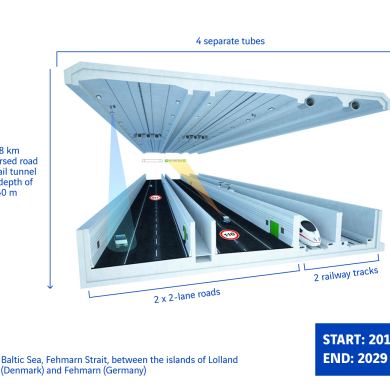
Fehmarn Belt Tunnel
Instead of a long ferry journey across the strait, the crossing will only take 10 minutes by car and 7 minutes by train. The cities of Hamburg and Copenhagen will be connected by a 2.5-hour train journey, compared to the current journey time of 4.5 hours and a 160 km detour. The volume of rail freight between Germany and Scandinavia is expected to undergo an 18% increase by 2040.
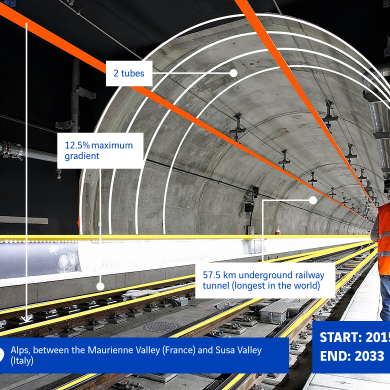
Euralpin Lyon-Turin Tunnel
Ambition: 22 trains a day compared to the current 6 trains a day on the historic Lyon-Turin line. The infrastructure will also be compatible with trains featuring a 1,500 t capacity vs. the current payload of 600 to 700 t.
This infrastructure will remove around one million trucks from the roads over the Alps every year, which also equates to a reduction of one million tons of CO2 each year.
Other obstacles to overcome21…
Although recent and future infrastructures are expected to significantly increase the efficiency and appeal of rail freight compared to long-distance road transport, the missing links are unfortunately not the only obstacles preventing a surge in rail travel. The TEN-T programme needs to tackle other issues at the same time, such as:
- Electrification: only 57% of the European railway network is electrified, meaning that not every end-to-end journey can be made without the use of a less eco-friendly diesel locomotive. Another complication concerns applicable electric standards, since not every EU country runs its network with the same current and power ratings.
- Signalling: signalling systems play a critical role in ensuring safety and free-flowing traffic, but they have been designed according to a wide range of country-specific standards. TEN-T is planning to harmonise this particular area by deploying the European Rail Traffic Management System (ERTMS) – which is a long-term project to replace the 27 current systems.
Sources :
[1] https://www.carbone4.com/analyse-faq-fret
[3] https://ec.europa.eu/commission/presscorner/detail/fr/fs_23_3771
[4] P18 du doc précité : https://librairie.ademe.fr/mobilite-et-transports/8126-avis-d-expert-sur-la-transition-de-la-logistique.html
[5] https://www.eea.europa.eu/en/topics/in-depth/transport-and-mobility
[8] https://www.railfreightforward.eu/sites/default/files/downloadcenter/greenbrochurewebldupdated.pdf
[9] https://databank.worldbank.org/source/world-development-indicators/Series/IS.RRS.GOOD.MT.K6
[11] https://ec.europa.eu/eurostat/web/products-key-figures/w/ks-01-24-021
[12] https://www.railfreightforward.eu/sites/default/files/downloadcenter/greenbrochurewebldupdated.pdf
[14] https://en.wikipedia.org/wiki/Rail_transport_in_Europe#Freight
Subscribe
Stay tuned : receive our newsletter
Every quarter, discover new articles, exclusive features and experts' views delivered straight to your inbox.
Most viewed
Explore more

Marina Lévy - Companies at the heart of ocean conservation issues
Marina Lévy, oceanographer, research director at the CNRS and ocean advisor to the president of the French National Research…
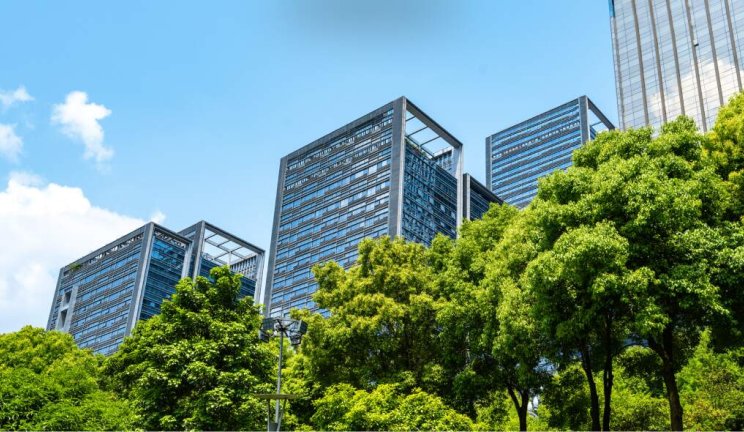
Building with and for nature
Whether creating barrages, stripping away topsoil, cutting down trees or digging channels, humans have spent thousands of…

Bridging the construction gender gap: paving the way to a career in industry for women in Colombia
In 2025, the Ruta 40 consortium led by VINCI Construction Grands Projets completed work on widening and upgrading the Bogotá…
